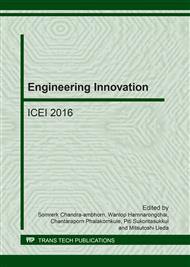[1]
J. Sheng, Growth of silver nanoclusters embedded in soda-lime silicate glasses, Int J Hydrogen Energ. 34 (2009) 2471- 2474.
DOI: 10.1016/j.ijhydene.2009.01.034
Google Scholar
[2]
P. Malinsky, A. Macková, J. Boc, B. Švecová, P. Nekvindová, Au implantation into various types of silicate glasses, Nucl Instrum Meth B. 267 (2009) 1575–1578.
DOI: 10.1016/j.nimb.2009.01.161
Google Scholar
[3]
J. Vosburgh, R. H. Doremus, Optical absorption spectra of gold nano-clustersin potassium borosilicate glass, J Non-Cryst Solids. 349 (2004) 309–314.
DOI: 10.1016/j.jnoncrysol.2004.08.211
Google Scholar
[4]
M. L. Braunger, C. A. Escanhoela Jr., E. C. Ziemath., Electrical conductivity of Ag–Na ion exchanged soda-lime glass, Solid State Ionics. 265 (2014) 55–60.
DOI: 10.1016/j.ssi.2014.07.015
Google Scholar
[5]
S. Tirtha, K. Basudeb, Nano Au enhanced upconversion in dichroic Nd3þ: Au–antimony glass nanocomposites, Solid State Sci. 11 (2009) 1044–1051.
DOI: 10.1016/j.solidstatesciences.2009.02.007
Google Scholar
[6]
J. Rozra, I. Saini, S. Aggarwal, A. Sharma, Spectroscopic analysis of Ag nanoparticles embedded in glass, Adv. Mat. Lett. 4 (2013) 598-604.
DOI: 10.5185/amlett.2013.1402
Google Scholar
[7]
J. Sancho-Parramon, V. Janicki, P. Dubc, M. Karlušic, D. Gracin, M. Jakšic, S. Bernstorff, D. Meljanac, K. Juraic, Optical and structural properties of silver nanoparticles in glass matrix formed by thermal annealing of field assisted film dissolution, Opt Mater. 32 (2010).
DOI: 10.1016/j.optmat.2009.11.004
Google Scholar
[8]
M.G. Ventura, A.J. Parola, A. Pires de Matos, Influence of heat treatment on the colour of Au and Ag glasses produced by the sol–gel pathway, J Non-Cryst Solids. 357 (2011) 1342–1349.
DOI: 10.1016/j.jnoncrysol.2010.12.013
Google Scholar
[9]
G. Venkateswara Rao, H.D. Shashikala, Optical, dielectric and mechanical properties of silver nanoparticle embedded calcium phosphate glass, J Non-Cryst Solids. 402 (2014) 204–209.
DOI: 10.1016/j.jnoncrysol.2014.06.007
Google Scholar
[10]
Y. Q. He, S. P. Liu, L. Kong, Z. F. Liu, A study on the sizes and concentrations of gold nanoparticles by spectra of absorption, resonance Rayleigh scattering and resonance non-linear scattering., Spectrochim Acta A. 61 (2005) 2861-6.
DOI: 10.1016/j.saa.2004.10.035
Google Scholar
[11]
J. Sancho-Parramon, V. Janicki, P. Dubc, M. Karlušic, D. Gracin, M. Jakšic, S. Bernstorff, D. Meljanac, K. Juraic, Optical and structural properties of silver nanoparticles in glass matrix formed by thermal annealing of field assisted film dissolution, Opt Mater. 32 (2010).
DOI: 10.1016/j.optmat.2009.11.004
Google Scholar
[12]
S. Haslbeck, K. P. Martinek, L. Stievano, F. E. Wagner, Formation of gold nanoparticles in gold ruby glass: The influence of tin, Hyperfine Interact. 165 (2005) 89-94.
DOI: 10.1007/s10751-006-9246-0
Google Scholar
[13]
R. Rajaramakrishna, Chatree Saiyasombat , R.V. Anavekar, H. Jain, Structure and nonlinear optical studies of Au nanoparticles embedded in lead lanthanum borate glass, J Non-Cryst Solids. 406 (2015) 107–110.
DOI: 10.1016/j.jnoncrysol.2014.09.052
Google Scholar
[14]
S.K. Ghosh, T. Pal, Interparticle Coupling Effect on the Surface Plasmon Resonance of Gold Nanoparticles: From Theory to Applications, Chem Rev. 107 (2007) 4797-862.
DOI: 10.1021/cr0680282
Google Scholar
[15]
T. Jitwatcharakomol, E. Meechoowa, M. Jiarawattananon, S. Jiemsirilers, Kinetic Investigation on the Color Striking of Gold Ruby Glass, Procedia Eng. 32 (2012) 584- 589.
DOI: 10.1016/j.proeng.2012.01.1312
Google Scholar
[16]
Y. Ruangtaweep, P. A-nupan, J. Kaewkhao, Preparation of Ruby Red Glasses from Gold Nanoparticles: Influence of Stannic Oxide, AIP Con P. 1589, (2014) 245.
DOI: 10.1063/1.4868792
Google Scholar
[17]
N. R. Wilk Jr, H. D. Schreiber, Optical properties of gold in acetate glasses, J Non-Cryst Solids. 239 (1998) 192–196.
DOI: 10.1016/s0022-3093(98)00738-8
Google Scholar
[18]
S. Link, M.A. El-Sayed, Size and Temperature Dependence of the Plasmon Absorption of Colloidal Gold Nanoparticles, J. Phys. Chem. B 103 (1999) 4212-4217.
DOI: 10.1021/jp984796o
Google Scholar
[19]
S. Qu, C. Zhao, X. Jiang, G. Fang, Y. Gao, H. Zeng, Y. Song, J. Qiu, C. Zhu, K. Hirao, Optical nonlinearities of space selectively precipitated Au nanoparticles inside glasses, Chem Phys Lett. 368 (2003) 352-358.
DOI: 10.1016/s0009-2614(02)01885-7
Google Scholar
[20]
H. Zeng, J. Qiu, Z. Ye, C. Zhu, F. Gan, Irradiation assisted fabrication of gold nanoparticles-doped glasses, J Cryst Growth. 267 (2004) 156–160.
DOI: 10.1016/j.jcrysgro.2004.03.041
Google Scholar


